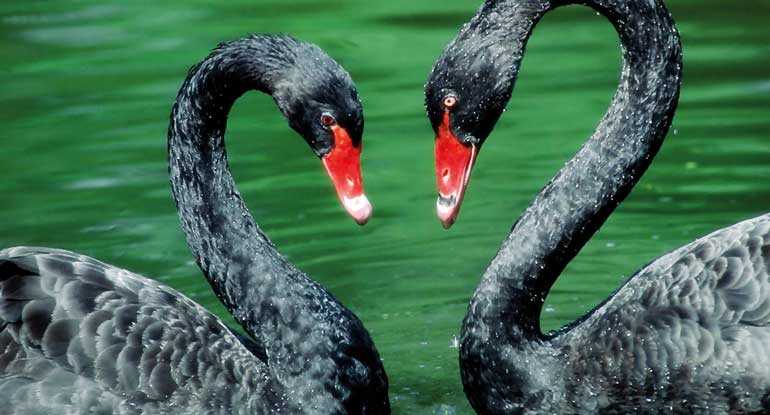Sunday Mar 09, 2025
Sunday Mar 09, 2025
Monday, 2 March 2020 01:07 - - {{hitsCtrl.values.hits}}

Years of brilliant marketing have convinced us all that travelling long distances is entirely normal. But that might have just changed as a result of two Black Swans
Swans, as we know, are large aquatic birds found in Europe and other temperate parts of the world. All European swans are unfailingly white, and for thousands of years people who were familiar with these birds assumed that they were always white-feathered – just as all crows are black. This was taken to be a universal truth.
When the first European sailors reached the southwest coast of Australia, they were astonished to see black swans. This was one of the many peculiarities of the strange animals native to this faraway land.
A Black Swan event
Today, a ‘Black Swan’ event is something that purports to illustrate the severe limitations of our experience and how existing knowledge can lead to a wrong conclusion. Just as everyone in Europe assumed that swans, like milk, were unfailingly white in colour – until that was proved to be a completely wrong assumption.
The New York Times defines a Black Swan event as follows: ‘First, it is an ‘outlier’, as it lies outside the realm of regular expectations, because nothing in the past can convincingly point to its possibility. Second, it carries an extreme impact. Third, in spite of its outlier status, human nature makes us concoct explanations for its occurrence ‘after’ the fact, making it explainable and predictable.’ It is the first two parts of this definition that concern us in today’s column.
Bird strikes
Aviation, particularly involving the use of large commercial jets, has an uneasy relationship with the birds of this world. The two species do not mix well, and one of the most famous episodes in aviation concerns an Airbus A320 airliner that hit a flock of geese (not swans), resulting in both engines losing power and a dramatic landing in New York City’s Hudson River. The Captain, Chesley ‘Sully’ Sullenberger, remains a folk hero to this day.
In a less literal sense, aviation has been hit by two Black Swan events in the last 10 months, which could possibly change the industry in profound ways.

The MAX and MCAS
Much has been written, in this column and elsewhere, of the debacle surrounding the Boeing 737 MAX. A design derived from an airplane type that never seemed to age, the MAX was once hailed as the best-selling aircraft of all time – and one of the safest. The order book stretched to over 5,000 unbuilt aircraft scheduled to keep the production line busy for many years.
But all it took was two fatal accidents, traced to an obscure piece of software that was supposed to be so insignificant that the pilots weren’t even told about it. The resulting furore and media hysteria have meant that the MAX has been grounded for 11 months now and may never regain full passenger confidence.
COVID-19
Just as the aviation business was slowly recovering from the first ‘black swan’ strike, a mystery virus surfaced in central China. Identified as COVID-19, or more commonly coronavirus, it occurred just as Asia was preparing for the Lunar New Year holidays early this year – together with Christmas and the Hajj, one of the busiest travel seasons in the world.
The effect has been catastrophic. Internal flying in China is down as much as 90% according to the New York Times (13,000 missing flights). Most foreign airlines have stopped flying into China. Many countries are preventing non-citizens from entering, if they have originated in China. The worldwide drop in traffic, with some exceptions, is estimated at 10 to 15% overall in the first quarter of the year.
Some carriers that depended on China for their traffic feed are facing catastrophic losses. Hong Kong’s Cathay Pacific is one of the worst affected foreign-owned airlines with an estimated 30% of its fleet grounded. The losses faced by Chinese-owned carriers are harder to estimate but must be crippling as well.
Saudi Arabia has suspended all pilgrim traffic to Mecca and there is a possibility that the Hajj (due in July-August this year) may be called off completely. The Summer Olympics scheduled for August in Tokyo, Japan are also under threat of cancellation.
Where will this end?
That is impossible to say at this time. China has reported (according to WHO figures as of 26 February 2020) 78,630 cases and 2,747 resultant deaths. With the virus having ‘clusters’ in South Korea, Iran and Italy, it appears to be highly mobile. Outside of China there have been 3,664 cases and 57 deaths – so the disease does not kill with the potency of SARS or MERS, two previous iterations of the pathogen. Yet it is frightening the entire world and removing the desire for people to travel.
Media-driven panic or a true pandemic?
Certainly, constant social media updates and a 24-hour news cycle have meant that we are far more aware of COVID-19 than we were of previous pandemics.
Similarly, the MAX flight control issues have led to more people becoming scared of flying than ever intended to get on an airplane. Previous, arguably more significant design issues, such as on the McDonnell Douglas DC-10 in the 1970s, were resolved without the hysteria surrounding the MAX crisis.
When and how easily the industry will recover from these two events remains to be seen. Aviation is almost totally dependent on non-essential travel. Years of brilliant marketing have convinced us all that travelling long distances is entirely normal. But that might have just changed as a result of two Black Swans.
(The writer has had a long career as an airline CEO, pilot and researcher. He has over 3500 hours on the Boeing 777 and is very familiar with this type of aircraft. More information is available on his blog surenratwatte.com)
Discover Kapruka, the leading online shopping platform in Sri Lanka, where you can conveniently send Gifts and Flowers to your loved ones for any event including Valentine ’s Day. Explore a wide range of popular Shopping Categories on Kapruka, including Toys, Groceries, Electronics, Birthday Cakes, Fruits, Chocolates, Flower Bouquets, Clothing, Watches, Lingerie, Gift Sets and Jewellery. Also if you’re interested in selling with Kapruka, Partner Central by Kapruka is the best solution to start with. Moreover, through Kapruka Global Shop, you can also enjoy the convenience of purchasing products from renowned platforms like Amazon and eBay and have them delivered to Sri Lanka.
Discover Kapruka, the leading online shopping platform in Sri Lanka, where you can conveniently send Gifts and Flowers to your loved ones for any event including Valentine ’s Day. Explore a wide range of popular Shopping Categories on Kapruka, including Toys, Groceries, Electronics, Birthday Cakes, Fruits, Chocolates, Flower Bouquets, Clothing, Watches, Lingerie, Gift Sets and Jewellery. Also if you’re interested in selling with Kapruka, Partner Central by Kapruka is the best solution to start with. Moreover, through Kapruka Global Shop, you can also enjoy the convenience of purchasing products from renowned platforms like Amazon and eBay and have them delivered to Sri Lanka.